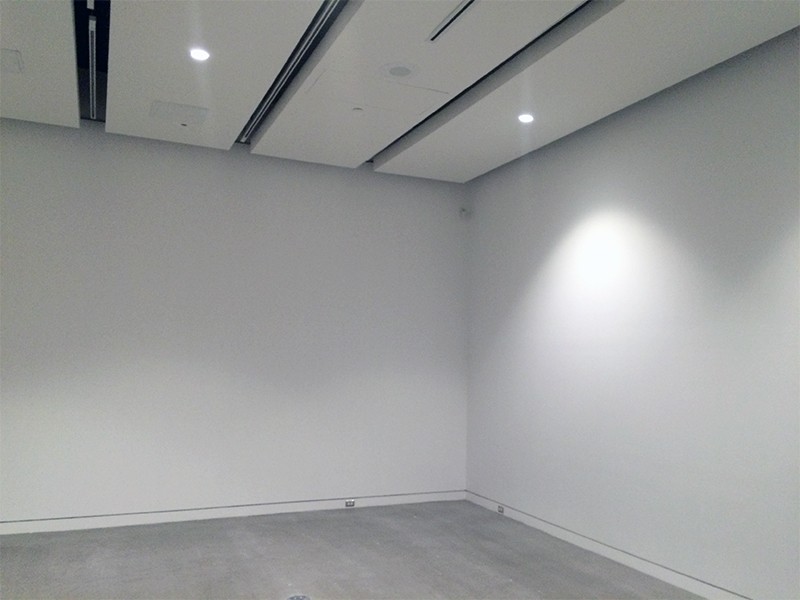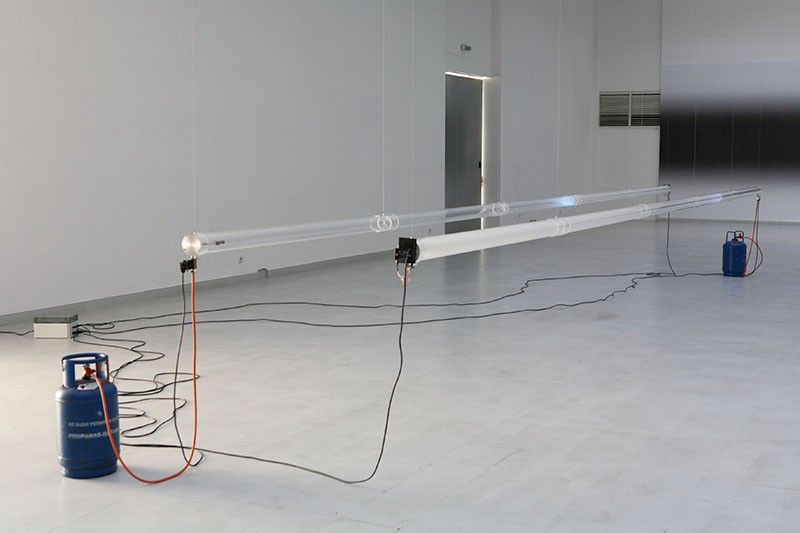
“The Centre of Silence” photo on http://newmediagallery.ca/
One room inside the New Media Gallery located on the 3rd floor of Anvil Center, New Westminster shows is a very unusual one. There is no artifact on exhibition in this room, instead, the room itself became an artifact. It is a piece called “the centre of silence”, created by Swedish musician, composer and visual artist Jesper Norda.
The set up of “the centre of silence” is very simple, or, in other words, next to nothing from visual side. The room itself looks empty and brightly lighted, several recorded messages are playing continuously from speakers. The speakers are set up in an very interesting manner that, they are all hidden from sight and distribute the voice evenly across the whole room, which means that the voice can be heard at exactly the same volume at any spot inside the room. The recorded voice contains a monologue divided in three segments, separated by silence, sine wave and white noise for respective segment, the monologue states the measure of the room, the composition, weight of the air inside the room, and even the shape and movement of the molecules. Each segments are a bit different from each other, and there are additional monologue in the second and third segments, indicating the activity of the molecules of air during the 220kHz sinus wave and white noise.
Upon entering the room, the bright empty set up immediately caught my eyes, I realized that a visual impact can occur on any situation, even if there is nothing. The room itself is not that big, but the empty set up makes the whole space feels much more huge than its actual size, and this spacious feeling is enhanced by the lighting of the set. The room is brightly illuminated, makes me to see every corner of the room clearly as soon as I entered the room, which washes away any mysterious element brought by the darkness or shadow, and made it clear that there is absolutely no object visually interesting in the room, instead, the empty space itself is the focus of interest.
Unlike the former set up in other exhibition, the monologue used here is a female voice instead of a male one. The voice is indeed delivered equally in the whole space, I tried to walk around for a bit inside the room, and surprisingly found out that every inch inside the room has the same experience in hearing the voice. I also checked the room closely, but could not found anything other than two sets of security motion sensors, the ceiling is spaced, and details cannot be seen from the floor, so I assume the speakers are hidden in the ceiling somewhere. The evenly distributed voice is a great reflection on the idea of “centre” part in the title of this piece: since you can hear things evenly anywhere in the room, it means that there is no actual “centre” of the voice in this space, or, in other words, the whole room itself is the centre.
It is also a very interesting idea that, Norda decided to play a monologue and some noise over this room repeatedly, instead of just leave it as it is, to reflect the name of this piece. It turns out that the monologue itself have enhanced the expression of the artifact. The visual set up of the room shows a minimalism design, and this design works exceptionally well with the facts of the room stated by the monologue, the contents are dry, but bring a consistency with the minimalism visual design. On the other side, these facts hinted me that the room is not empty at all: it is filled by air, when the monologue stated the weight of the air, I had a strange feeling as if I can actually feel the heavy air on me, and when the monologue stated the motion of the molecules, I can imagine that I can actually hear the motion, these dry monologues brings a spark for me to imagine all kinds of things which I had never thought of before. The noise between the segments are also interestingly designed: after the first segment, there is only silence, which reflects the “silence” concept in the title; the sinus wave after the second monologue segment take a step forward from the last segment, the unpleasant noise is the opposite to silence, but when the noise is gone, the 1 minute silence can be felt more “silenced” than before; after the last segment of monologue, the white noise is louder and more unpleasant than the sinus wave, thus the silence after the white noise is the most “deadly” silence than the previous two. The author uses three different kind of set up to escalate the degree of silence, which is a great reflection of theme of this artifact.

“334m/s” by Carsten Nicolai
There is one more interesting fact to this piece of artifact, and it is something can only be experienced in New Media Gallery. There is another artifact exhibiting in the next room, which is “334m/s” by Carsten Nicolai. This piece is set off every ten minutes, igniting a flame burns in a tube, from one side to the other, and creates a very loud explosion sound which can be heard even in the “centre of silence” room. Perhaps this set up is not done on purpose, but I have heard the loud explosion inside the “centre of silence” room while everything is in deadly silence, which, in my mind, actually enhances the experience of “centre of silence”: since you are in the centre of silence, the distant noise from the external world can be perceived as a connection between you, the artifact and the world, reminding you are still in the reality. On the other hand, part of the idea of Nicolai’s artifact is also delivered through this somewhat strange way.
Reference:
Introduction of “Centre of Silence” and “334m/s” from New Media Gallery website
Jespa Norda’s portfolio http://www.jespernorda.com/pdf/jespernorda_portfolio.pdf
Leave me a Comment
You must be logged in to post a comment.